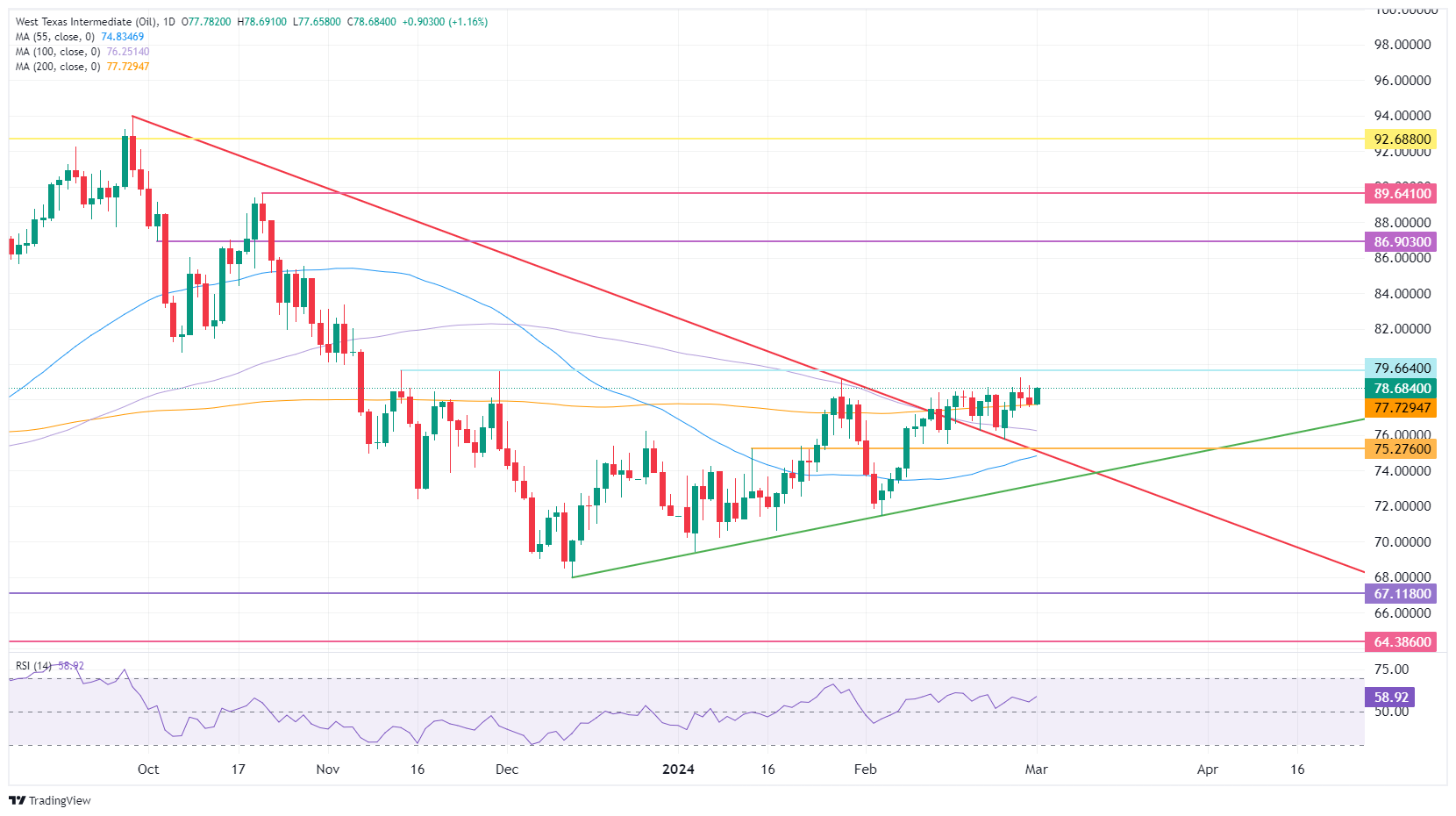WTI Oil jumps to $78 as markets expect OPEC production cuts to extend into Q2
- WTI Oil jumps to $78, trying to break higher.
- Oil traders are seeing bullish signals as US macroeconomic data points to a recovery and OPEC looks set to lengthen its production cuts.
- The US Dollar Index is back above 104.00, though it is unable to clearly break away from a pivotal level.
Oil prices jumped on Friday, trading above $78 in the European trading session, in what already has been a profitable week for Oil. Markets are on the lookout for confirmation that OPEC will prolong its current production cuts into the second quarter of the year. Although these production cuts are voluntary, they are a key factor in helping sustain Oil prices at the current levels.
Meanwhile, the US Dollar Index (DXY) is trading in a very tight range despite the release of important economic data and a whole army of US Federal Reserve speakers releasing comments to the markets throughout the week. Tensions are building up in markets: While Fed officials talk about the timing for an interest-rate rate cut or the number of upcoming cuts, recent inflation data points to the possibility of a rate hike to counterweight the possible second-round effects in inflation.
Crude Oil (WTI) trades at $78.50 per barrel, and Brent Oil trades at $82.45 per barrel at the time of writing.
Oil news and market movers: OPEC production cuts are necessity
- This week's US stockpile data revealed that the US is restocking at a ferocious pace. Data from the American Petroleum Institute and the Energy Information Administration pointed to a substantial build in stock.
- At 18:00 GMT, the weekly Baker Hughes Oil Rig Count will be published. The previous reading was at 503.
- OPEC has no choice but to prolong current production cuts if it does not want to trigger a substantial nosedive move in Crude prices.
- A significant part of the Libyan Oil supply came back online after protests ended at one of its major Oil fields.
Oil Technical Analysis: Risk of OPEC dropping the ball
Oil prices get support from the fact that traders expect OPEC to do whatever is needed to maintain the current price levels. That of course is a bit of a gamble as the current production cuts among OPEC countries are voluntary, and can only be confirmed after real export numbers are published.. Should OPEC really want to matter, not only a prolonging but a deepening further of these production cuts could be needed.
Oil bulls are focusing on the double top near $79.66, ahead of $80.00. Once through that area, quite a large room opens up towards $86.90, which would mean a nearly 10% gain. Just ahead of $90, $89.64 could stand in the way of heading towards $100.00.
On the downside, the 200-day Simple Moving average (SMA) near $77.72 is the first point of contact to provide some support. Quite close following suit are the 100-day and the 55-day SMAs near $76.25 and $74.83, respectively. Add the pivotal level near $75.27, and it looks like the downside is very limited and well-equipped to resist the selling pressure..

US WTI Crude Oil: Daily Chart
WTI Oil FAQs
What is WTI Oil?
WTI Oil is a type of Crude Oil sold on international markets. The WTI stands for West Texas Intermediate, one of three major types including Brent and Dubai Crude. WTI is also referred to as “light” and “sweet” because of its relatively low gravity and sulfur content respectively. It is considered a high quality Oil that is easily refined. It is sourced in the United States and distributed via the Cushing hub, which is considered “The Pipeline Crossroads of the World”. It is a benchmark for the Oil market and WTI price is frequently quoted in the media.
What factors drive the price of WTI Oil?
Like all assets, supply and demand are the key drivers of WTI Oil price. As such, global growth can be a driver of increased demand and vice versa for weak global growth. Political instability, wars, and sanctions can disrupt supply and impact prices. The decisions of OPEC, a group of major Oil-producing countries, is another key driver of price. The value of the US Dollar influences the price of WTI Crude Oil, since Oil is predominantly traded in US Dollars, thus a weaker US Dollar can make Oil more affordable and vice versa.
How does inventory data impact the price of WTI Oil
The weekly Oil inventory reports published by the American Petroleum Institute (API) and the Energy Information Agency (EIA) impact the price of WTI Oil. Changes in inventories reflect fluctuating supply and demand. If the data shows a drop in inventories it can indicate increased demand, pushing up Oil price. Higher inventories can reflect increased supply, pushing down prices. API’s report is published every Tuesday and EIA’s the day after. Their results are usually similar, falling within 1% of each other 75% of the time. The EIA data is considered more reliable, since it is a government agency.
How does OPEC influence the price of WTI Oil?
OPEC (Organization of the Petroleum Exporting Countries) is a group of 13 Oil-producing nations who collectively decide production quotas for member countries at twice-yearly meetings. Their decisions often impact WTI Oil prices. When OPEC decides to lower quotas, it can tighten supply, pushing up Oil prices. When OPEC increases production, it has the opposite effect. OPEC+ refers to an expanded group that includes ten extra non-OPEC members, the most notable of which is Russia.

